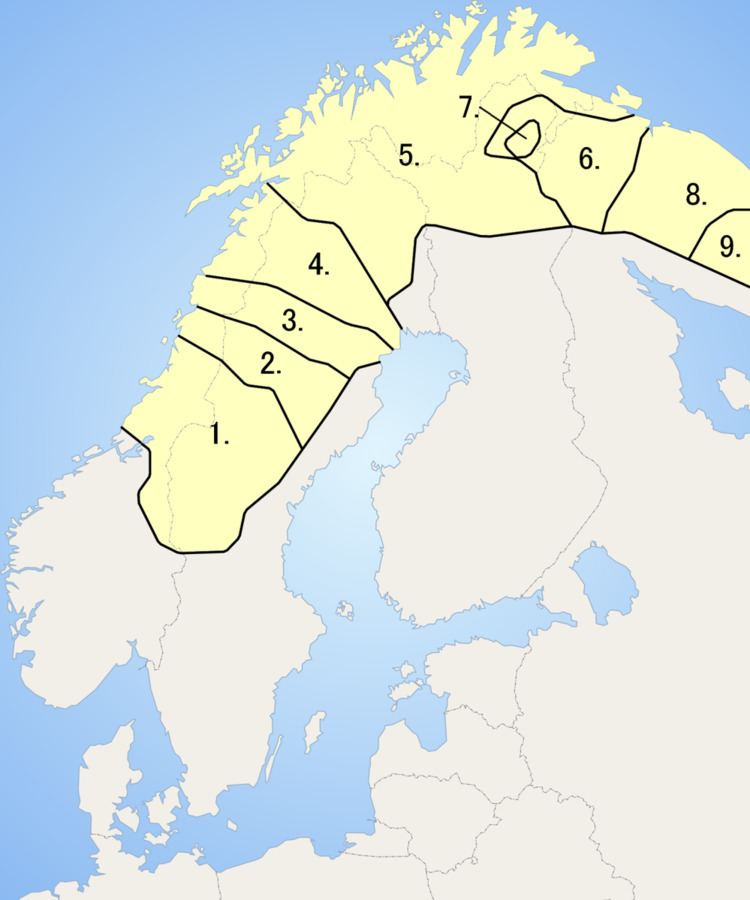Native to Norway, Sweden Writing system Latin ISO 639-2 smj | Native speakers 1,000–2,000 (2007) Recognised minority
language in Norway; Sweden | |
 | ||
Language family Uralic
Sami
Western
Lule Sami | ||
Lule Sami (julevsámegiella) is a Uralic, Sami language spoken in Lule Lappmark, i.e. around the Lule River, Sweden and in the northern parts of Nordland county in Norway, especially Tysfjord municipality, where Lule Sami is an official language. It is written in the Latin script, having an official alphabet.
Contents
Status
With 1,500 to 2,000 speakers it is the second largest of all Sami languages. It is reported that the number of native speakers is in sharp decline among the younger generations. The language has, however, been standardised in 1983 and elaborately cultivated ever since.
Cases
Lule Sámi has seven cases:
Nominative
Like the other Uralic languages, the nominative singular is unmarked and indicates the subject of a predicate. The nominative plural is also unmarked and is always formally the same as the genitive singular.
Genitive
The genitive singular is unmarked and looks the same as the nominative plural. The genitive plural is marked by an -j. The genitive is used:
Accusative
The accusative is the direct object case and it is marked with -v in the singular. In the plural, its marker is -t, which is preceded by the plural marker -j.
Inessive
The inessive marker is -n in the singular and the plural, when it is then preceded by the plural marker -j. This case is used to indicate:
Illative
The illative marker is -j in the singular and -da in the plural, which is preceded by the plural marker -i, making it look the same as the plural accusative. This case is used to indicate:
Elative
The elative marker is -s in the singular and the plural, when it is then preceded by the plural marker -j. This case is used to indicate:
Comitative
The comitative marker in the singular is -jn and -j in the plural, which means that it looks like the genitive plural. The comitative is used to state with whom or what something was done.
Pronouns
The personal pronouns have three numbers - singular, plural and dual. The following table contains personal pronouns in the nominative and genitive/accusative cases.
The next table demonstrates the declension of a personal pronoun he/she (no gender distinction) in various cases:
Person
Lule Sami verbs conjugate for three grammatical persons:
Mood
Lule Sami has 4 grammatical moods:
Grammatical number
Lule Sami verbs conjugate for three grammatical numbers:
Tense
Lule Sami verbs have two simple tenses:
and 2 compound tenses:
Negative verb
Lule Sami, like Finnish, the other Sámi languages and some Estonian dialects, has a negative verb. In Lule Sami, the negative verb conjugates according to tense (past and non-past), mood (indicative and imperative), person (1st, 2nd and 3rd) and number (singular, dual and plural).
Writing system
The orthography used for Lule Sámi is written using an extended form of the Latin script. There are a few special characters: á (a-acute), ń (n-acute), and å (a-ring). Traditionally, the character n-acute (Ń/ń) has been used to represent the [ŋ] sound, found, for example, in the English word "song". In place of n-acute (found in Unicode, but not in Latin-1 or traditional Nordic keyboards), many have used ñ or even ng. In modern orthography, such as in the official publications of the Swedish government and the recently published translation of the New Testament, it is usually replaced with ŋ, in accordance with the orthography of many other Sami languages.
